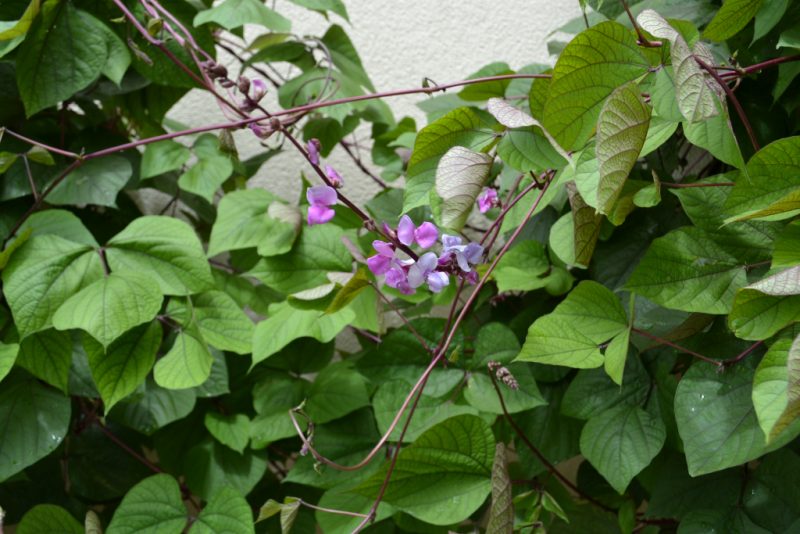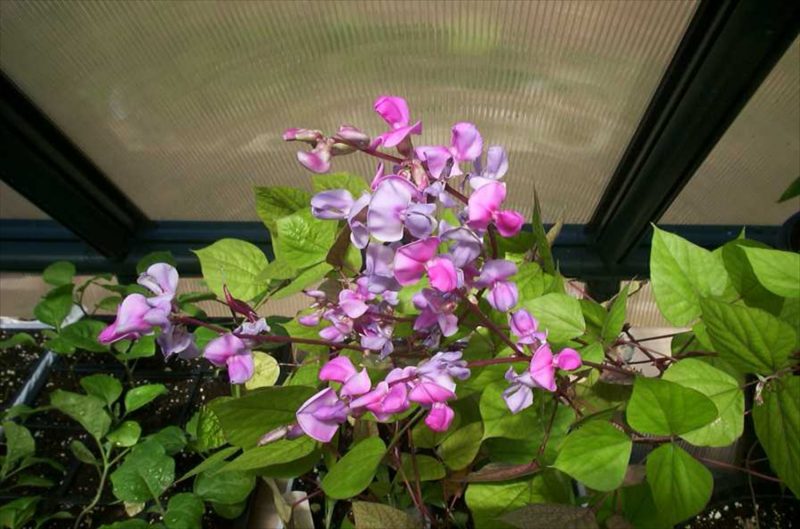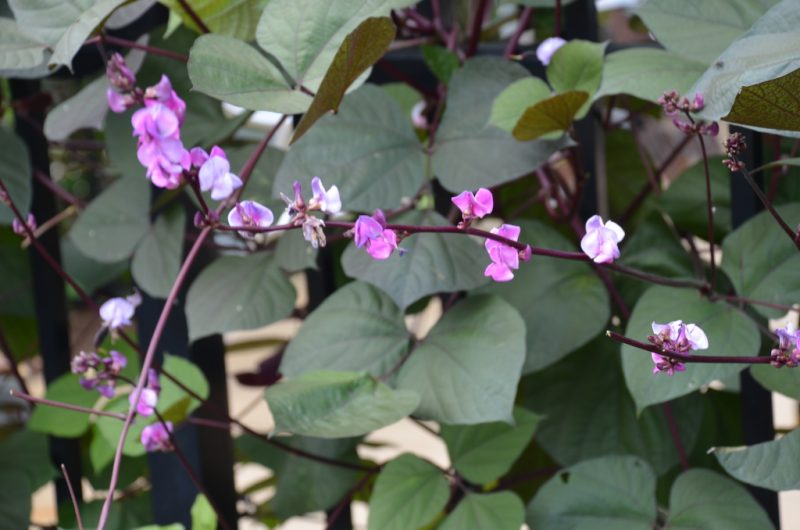Hyacinth beans - a beautiful climbing plant, unusual for Russian gardeners. With it, you can create luxurious hedges. Information on how to plant and grow it will be useful to everyone who decides to decorate their site with such an exquisite culture.
Material Content:
Botanical Description

Lobia, or hyacinth beans, is an annual vine with a long, 4-meter stalk and large leaves consisting of 3 separate leaves. Arboreal inflorescences from fragrant flowers are painted in white, purple or reddish color. Flattened, curved beans have a pointed tip and contain from 2 to 4 large seeds of white or black color.
Growing Hyacinth Beans from Seeds
Beans in open ground can be sown in mid-May. Germinating, they require a lot of moisture. The optimum temperature for germination is 19 - 20 ° C. Shoots can appear in a week, so if there is a threat of frost, they can be covered with a film.

If you want to get flowering plants earlier, you can grow beans through seedlings. Sowing should be a month before planting in open ground in peat pots, and then directly into them and placed in a permanent place. You can start home sowing in the second decade of April.
To plant the beans, you need to carry out pre-sowing preparation - scarification.
For this purpose, you need 2 sheets of sandpaper, between which you need to rub the seeds for several seconds. Due to this, the strong shell is broken, and it will be easier for the seeds to germinate.
For planting you will need a small container or peat pots filled with nutritious soil.
- Having well moistened the soil from the spray, seeds are laid out on its surface.
- Using a finger, gently deepen them by 1.5 cm.
- Landing containers are covered with a transparent lid and placed in a bright, warm place. Air temperature should not be lower than 20 ° C.
- The soil is moistened as it dries.
After about 5 days, friendly shoots will appear. Further care is regular watering, drying out of the soil should not be allowed.
A week after germination, real leaflets will appear. Seedlings continue to be watered, and in the second decade of May they can be transplanted into the open ground.
How and when to plant a vegetable crop
Beans grow well on various substrates, except acidic, swampy and sandy. Soil that retains moisture well is best suited. If regular watering is possible, beans can be planted on light sandy soils.

Beans do not tolerate excess moisture. For their landing, it is necessary to allocate areas that are early released from snow. The best bean precursors are vegetables, under which organic fertilizers were applied. At the same place, it is advisable to plant the plant no more than 1 time in 4 to 5 years.
The cultivation of the soil for beans should be deep, up to 20 - 25 cm. Digging up the site can be done in the fall and then rotted manure and mineral fertilizers (phosphorite flour) should be kept.
Hyacinth beans should be planted near the support. They quickly grow up, braiding vertical fences and walls.
- The landing site should be well lit.
- You can bring a little compost to the area where the beans will grow.
- Seedlings are planted on a prepared place at a distance of about 40 cm, between the rows leave 70 cm.
- Lightly compact the soil with your hands to fix the plants.
- It is advisable to mulch the soil so that it dries less.
- A peg with a tied rope is stuck next to each seedling to direct the growth of the beans.
- Then the plants are abundantly watered and left alone for several days.
Outdoor Care
Hyacinth beans need easy maintenance for normal development. They make sure that there are no weeds, loosen the soil around the plants, water them on time, avoiding strong drying out. In the first month after planting in a permanent place, the beans need daily watering.

- Lighting. The culture belongs to the plants of a long day. If it is short, flowering and fruiting are strongly delayed in beans.
- Loosening. Bean care includes soil loosening and hilling.
- Humidity. The drought, even a short one, the beans can’t stand it, it is a very moisture-loving plant. If the soil and air are dry, the number of flowers will decrease, and the ovaries may fall.
- Top dressing. When planting on poor soils, it is advisable to use mineral fertilizers weekly. At the beginning of the vegetation, nitrogenous, and then potassium and phosphorus. Excess fertilizer for plants is also harmful, otherwise they will accumulate green mass, but not bloom.
- Soil acidity. Beans grow well on neutral, loose soil, in acidic soil they develop poorly, they may not even bloom.
- Diseases Plants are resistant to all pests and diseases. If small yellow spots appear on the leaves in August, this indicates a lack of fertilizer. It is advisable to apply potassium-phosphorus fertilizing after watering the soil.
The plant blooms in mid-summer, and continues to bloom until late autumn. Inflorescences bloom one after another, and each individual flower lives no more than 3 days. Up to fifty flowers can be collected in one brush. If the plant is grown only for decorative purposes, wilted inflorescences are cut off so that efforts are not spent on setting fruit.
The use of hyacinth beans
Since ancient times, the plant has been used as a vegetable crop. Beans grow with wide, short pods with small seeds. Garnishes are prepared from them, added to soups, vegetable stews, salads.

Hyacinth beans serve deliciously with meat and seafood. You can cook not only seeds, but also unripe pods. It is convenient to freeze or preserve them for the winter.
In addition to cooking, beans are used in cosmetology, making powders and powder from them.In ancient times, various diseases were treated with their help. Beans are also a valuable fodder crop, their green mass contains a lot of protein. Leaves, stems, pods and seeds go to animal feed.
For decorative purposes, the plant is used to decorate the garden. A long, curly stalk beautifully braids arbors, awnings, forged lattices and fences. For wonderful large flowers it is also called curly lilac.












